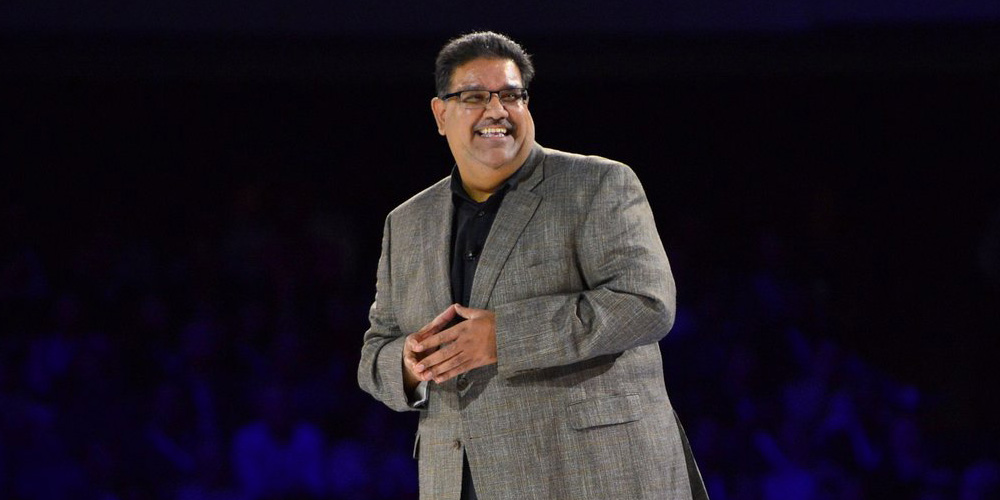 INFRA
INFRA
 INFRA
INFRA
 INFRA
INFRA
Intel Corp. Chief Engineering Officer Venkata Murthy Renduchintala seems to be taking the fall for the company’s failure to deliver on its next-generation products based on its seven-nanometer chipmaking process.
The company, which revealed during its second-quarter earnings call last week that its 7nm chips are likely to be delayed, said today that Renduchintala (pictured) will depart on Aug. 3. It added that it will not seek a replacement for his role as chief engineering officer of its Technology, Systems Architecture and Client Group or TSCG, as the unit will instead be split into five separate teams.
Intel said last week that its first 7nm products, which include a new client central processing unit, will be delayed by six more months as a result of slower-than-expected progress with its next-generation manufacturing process. The new chips are now 12 months behind schedule.
The 7nm process involves squeezing smaller transistors onto a computer chip. By fitting more transistors onto a piece of silicon, it’s possible to make those chips more powerful and complex.
“We have identified a defect mode in our 7nm process that resulted in yield degradation,” Intel Chief Executive Bob Swan said last Thursday. “We’ve root-caused the issue and believe there are no fundamental roadblocks.”
Intel hired Renduchintala in 2015 as president of its Client and IoT Businesses and Systems Architecture Group. The former Qualcomm Inc. executive was later appointed head of the TSCG group, and was primarily responsible for leading development of the 7nm process.
That’s why his departure doesn’t come as a surprise, Charles King of Pund-IT Inc. told SiliconANGLE.
“He’s had half a decade after coming over from Qualcomm to pull things together, including Intel’s manufacturing efforts,” he said. “If anyone was going to take the fall for the recent 7nm setbacks, Murthy was the guy.”
Patrick Moorhead of Moor Insights & Strategy said that heads always roll at corporations when there’s a major schedule slip, and that’s especially true when the company suffers big repercussions as a result.
“I think the biggest issue was the market action, with the company’s value declining 16%, which is unprecedented in its recent history,” Moorhead said.
Constellation Research Inc. analyst Holger Mueller added that Renduchintala’s departure coming so soon, Intel is making the delay look even worse. “This looks bad for everyone involved, as technology misses do not happen suddenly, but on a sliding scale.”
With Renduchintala going, Intel said the TSCG group will be split into the following teams: Technology Development, Manufacturing and Operations, Design Engineering, Architecture Software and Graphics, and Supply Chain.
In a statement, Intel said the changes were designed to “accelerate product leadership and improve focus and accountability in process technology execution.”
The most important of the new teams appears to be Technology Development, which will be led by Intel’s former manufacturing head Dr. Ann Kelleher.
Kelleher, who oversaw the ramp up of Intel’s 10nm process, will be tasked with leading the development of its 7nm and 5nm processes. She’ll be assisted in the interim by Dr. Mike Mayberry, a key figure at the Intel Labs research division, ahead of his retirement at the end of the year.
Manufacturing and Operations will be led by Keyvan Esfarjani, who was previously responsible for manufacturing at Intel’s nonvolatile memory business. Meanwhile, Josh Walden, who leads Intel’s Product Assurance and Security Group, will head up the Design Engineering team on a temporary basis until a permanent appointment can be made. Raja Koduri will continue to lead Architecture, Software and Graphics and Dr. Randhir Thakur will stay on as head of Supply Chain operations.
King said that by breaking its TSCG into smaller bits, Intel should be able to improve its manageability and oversight.
“The larger news was CEO Swan stating that Intel would consider partnering with other manufacturers on 7nm production rather than building its own fab,” King said. “That makes sense both strategically and financially since the company can’t continue throwing money at failing process efforts indefinitely. But that concession also qualifies as a major cultural shift for Intel.”
Moorhead added that he was confident the new leaders would be able to steady the ship at Intel, even though it faces pressure to resolve the challenges with its fab as soon as possible.
“Intel will be fine in the long run,” he said. “It’s important for people to realize that winning in semiconductors is not just about nanometers. Platforms, business relationships and marketing matter a lot too, and these are advantages that Intel has.”
THANK YOU